Varanasi, one of the oldest continuously inhabited cities in the world, has been described in many ways, but calm, restful and quiet would never be among the chosen adjectives. Of all our destinations in India, this was the one I was most apprehensive about – anticipating noise, sights and smells that would be well beyond my comfort zone.
Well, even my fevered imagination could not have summoned the Hieronymus Bosch landscape that is Varanasi. From the moment we left the airport and drove into town, we bounced and jostled along a broken-down goat path, passing small groups of men huddled over fires, tarps strung over falling-down shacks and animals wandering down dark lanes. It felt like travelling through a post-apocalyptic refugee camp.
As we drove closer to the city centre, we came upon this scene. A massive wedding was underway and the festivities had moved into the street.
On the advice of a friend, we opted to stay right in the old part of the city – made up of ancient crumbling buildings and alleyways so narrow that cars cannot pass through. Lodgings in this area are less than pristine, but to stay elsewhere is to miss out on the essence of Varanasi. The driver led us down a long alleyway to our guesthouse and while it is not exactly dirty, it is not exactly clean either. That has been our experience with restaurants (Lonely Planet-approved) as well – the tables might be sticky and the windows smudged, but they are clean-ish. Good enough – this will not be the city where we tempt fate with the street food.
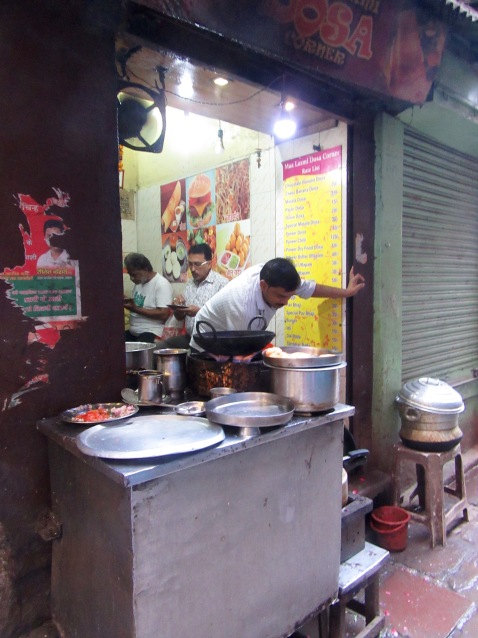
To describe Varanasi as being filthy is like describing Bill Gates as being rich. Buildings and doors and paving stones are crumbling. Water leaks out of crevices and runs down gutters. Garbage piles up in corners. Animals roam as freely as humans – dogs, cows, water buffalo, goats, monkeys – and the streets are their toilets. It is no small feat to walk around the alleyways, dodging animal (and possibly human) shit, great gobs of spit and nasty little puddles of murky water. It smells just as appetizing as it sounds. Add the constant sound of chest-rattling horks and spits, and it can be a full-on sensory overload. “Mouth breathe. Mouth breathe” has become my mantra.
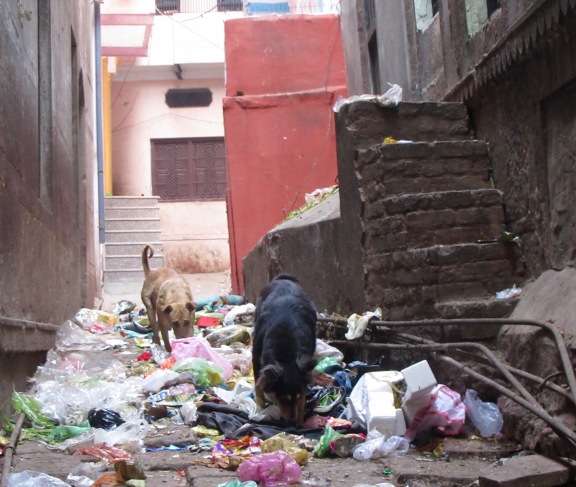
Varanasi is a holy city. Myths and mysticism date back 10,000 years and pilgrims, both Hindu and non-Hindu, travel here for spiritual enlightenment.
Besides the 2000 temples in the area, the main draw are the more than 80 ghats (stone steps) that line the Ganges River. Two and a half million people come each year to bathe in the waters and receive blessings. In addition there are 300 cremations every day. Being cremated in Varanasi on the Ganges is very desirable – it is said to break the cycle of birth and death.
Finding peace after death supposedly requires 350 kilos of mixed wood to burn one body and the cost to families can be over 10,000 rupees ($2000).
We watched a couple of funeral processions. Bodies are wrapped in colourful cloths, anointed with fragrant oils and brought down to the river to be immersed. Obviously photos of the actual cremation are strictly forbidden, but we were allowed to take photos of the massive woodpiles.
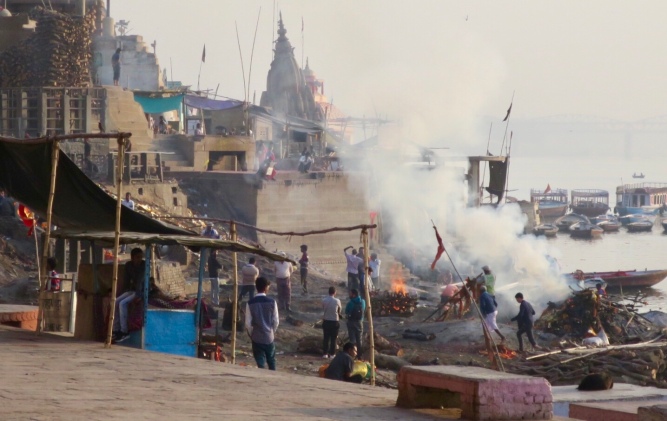
The Ganges River is one of the most revered rivers in the world and it is also the second most polluted – so much so that even touching the water is considered dangerous. However, that does not deter many Indians, who believe that bathing in the water will release suffering. While the river plays an obvious holy role in the death of its citizens, it is also where much of daily life revolves – bathing, swimming and laundry. We even watched one man fill his plastic bottle with water from the river and drink it.
Think of old city Varanasi as a crescent, with a path that follows for about 6 km. and at least 80 ghats dropping down to the river. To reach the old city from the ghats, you must climb up steep stone steps that lead into a labyrinth of alleys. We were not that interested in visiting temples, so spent our time right in old city. The best time to visit the ghats is dawn and dusk, for the diffused light and the cooler temperatures.
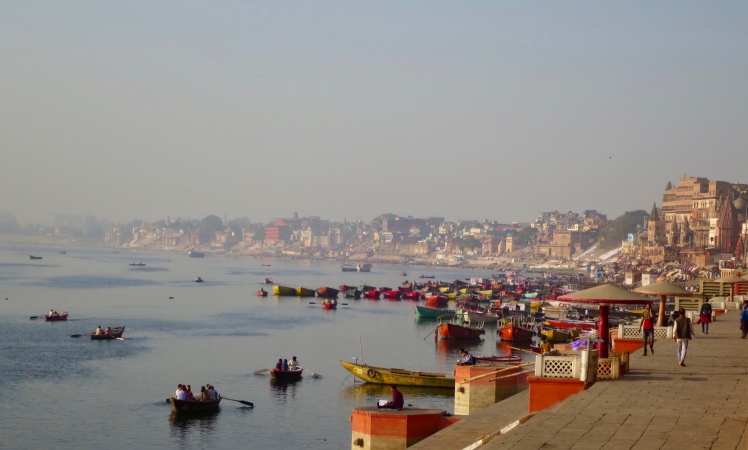
We had read about the persistent vendors, the young children begging and the sadhus or holy men who are looking for photo op cash. They were all there in abundance which made the atmosphere far less peaceful than it should have been in a holy city.
The children broke our hearts. These are not the happy little faces we’ve been seeing throughout India. These kids approach with hands held out and practiced sad faces – tilted to one side. It is very difficult to walk past them, but that is what we’ve been told to do – the country really wants to discourage this practice, in an effort to have these children in school rather than begin or selling on the street. A noble notion, to be sure, but we saw so many kids on their own, without an adult in sight.
These kids are so vulnerable – half of India’s children live in acute poverty. Figures for missing children go as high as 500,000 each year and those numbers are considered conservative as many are unreported.
These kids had cleverly strung up a pole across part of the walkway; stopping passersby for a five rupee toll.

We watched the mother of this tiny boy send him off with a bag of trinkets, presumably to sell them with his older brother. He struggled along, pants in one hand and bag in the other.
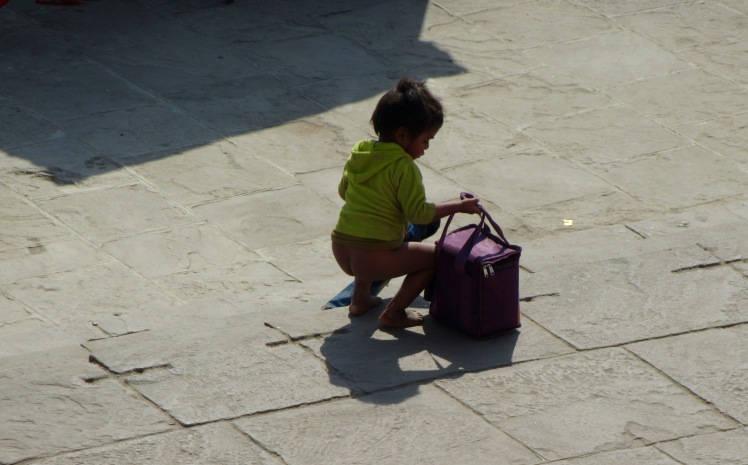
This little boy tugged at my heartstrings – so young and so alone.
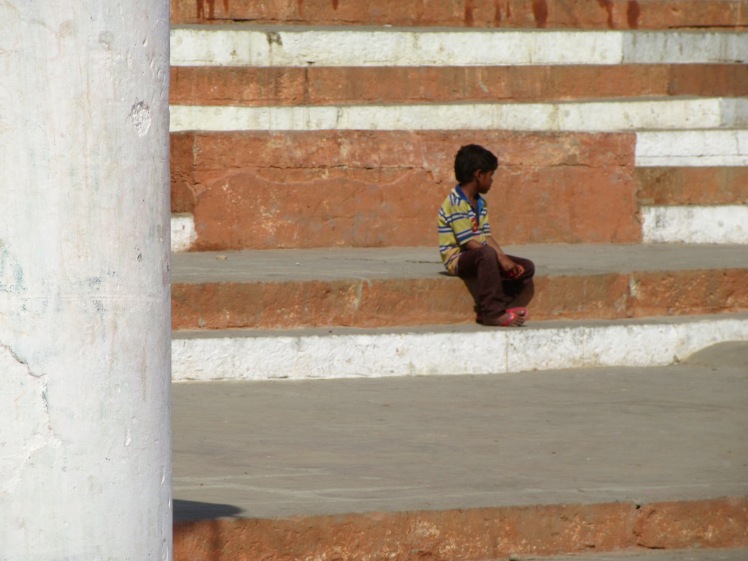
The animals don’t fare any better – dogs are skin and bones and covered in mange. I witnessed a few moments of kindness – a man stopping by to drop bits of food to the street dogs, and this man – so gentle with the puppy.
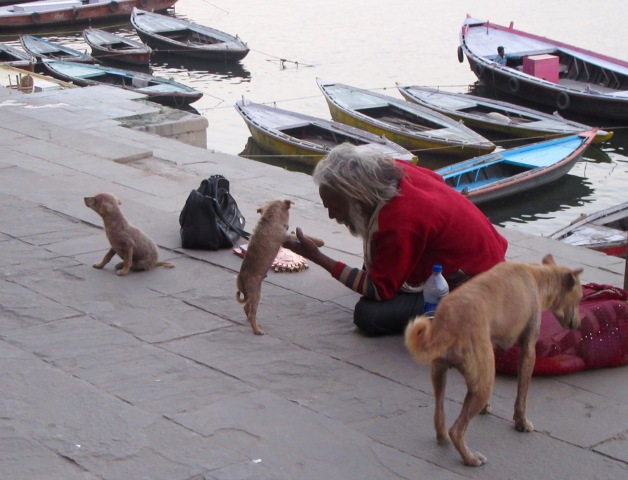
The number of beggars in Varanasi is really distressing. People with gross facial deformities, club feet, open skin lesions, missing limbs, missing eyes – all in desperate need of help.
We spoke to a young man who is in Varanasi to earn his Masters degree in English. We asked about the street kids and he acknowledged the problem in Varanasi was very bad. His view was that everyone we saw had a place to live ( a mat on the ground) and food to eat (scraps) and a job to do (begging). The next life would provide better circumstances. The Hindu belief in reincarnation supports that thought, but since everyone is bathing in the Ganges to reduce suffering, it is hard to imagine that people are sanguine about their station in life. To witness such wretchedness is almost more than we can bear.
We watched young mothers begging with their babies – in one case a young girl slapped her baby to make him cry and hopefully elicit some sympathy. She looked like a little animal – hard and desperate, as of course, she was.
This young woman was stationed outside the restaurant we ate at regularly, her hand out for spare change.
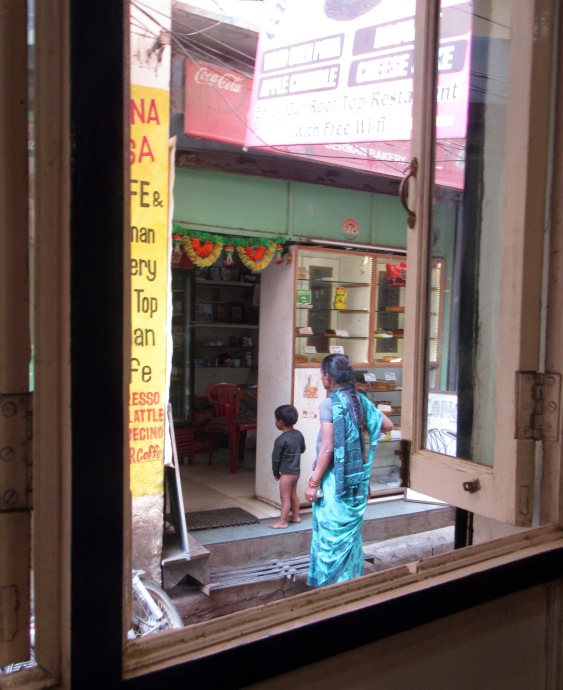
The sadhus (holy men) are fascinating. Most of them go about their business, and will offer blessings for a coin.
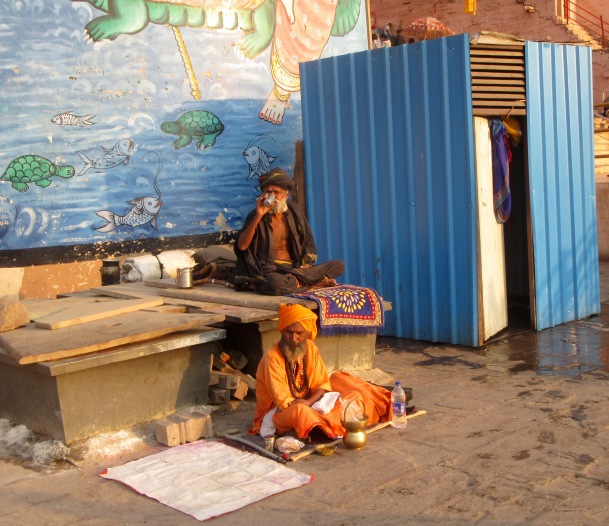
Others will stroll by, eyes sunk deep in their lined faces, smile and mutter, “photo. photo.”
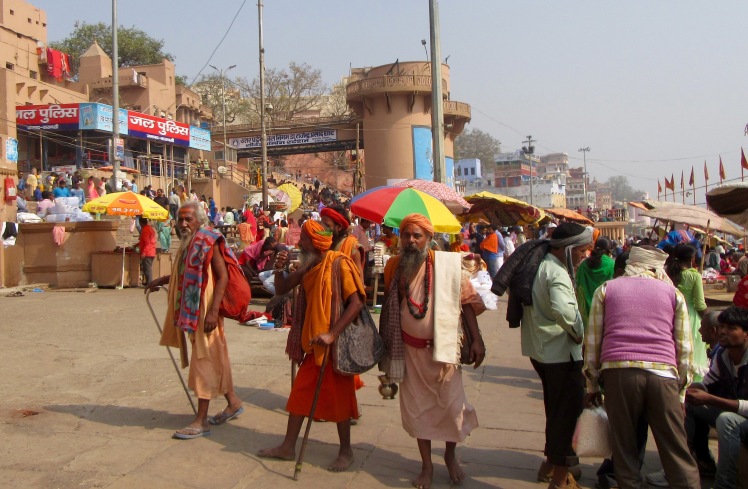
The vendors were easy enough to brush off. We learned not to engage in conversation, not to allow someone to grab our hands, and to just keep walking. It didn’t feel polite, but it felt way happier than being trailed and hassled.
There were many people who smiled and said, “namaste”, and kept walking. They didn’t want anything , they just wanted to be kind. They saved us, as we were becoming quite soured by everything.
One big attraction in Varanasi is to take a boat out on the Ganges at dawn or dusk. We chose a sunset cruise for 1 hour for roughly $5 and found our way down to a tiny wooden boat that already had three other people in it. Very convivial company, but our boatman pulled a classic trick – “I can take you out for an extra 1/2 hour and then you’ll see the show as well.” Steve and I had already seen the show (more later), but the other three had not, so we went along with it. The 1 1/2 hours turned into 2 hours and cost everyone double – not a big deal at $10, but it was the principle of the thing. We are so tired of being grabbed at for every last rupee, and having little tricks like this played on us and being outright lied to. It becomes exhausting.
The sunset cruise was not that interesting – we would have been better off getting up at 5:30 am for the sunrise. However, we did see the Aarti Ganga show from the water’s perspective, surrounded by dozens of other boats.
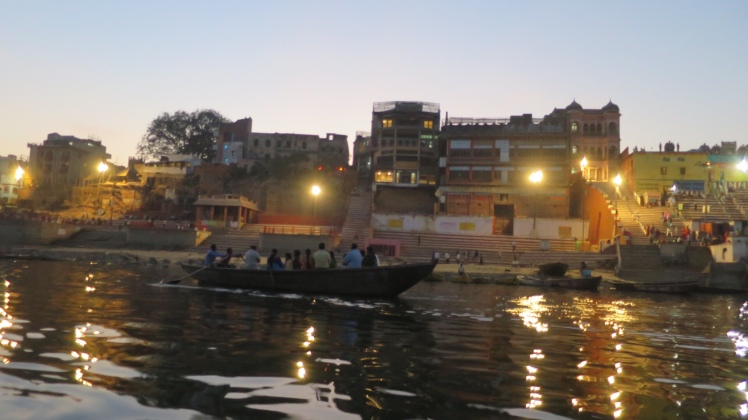
The night before, we saw the Aarti Ganga show from shore. It is quite a spectacle that is held every night – to thank the five gods of the river.
Varanasi has been way harder than we thought it would be. We’ve been trying to find the beauty and the redemption here, and have to remember than for so many, that is exactly what Varanasi offers.
To leave on a happier note, some images of Varanasi that will stick with us.
Meditation
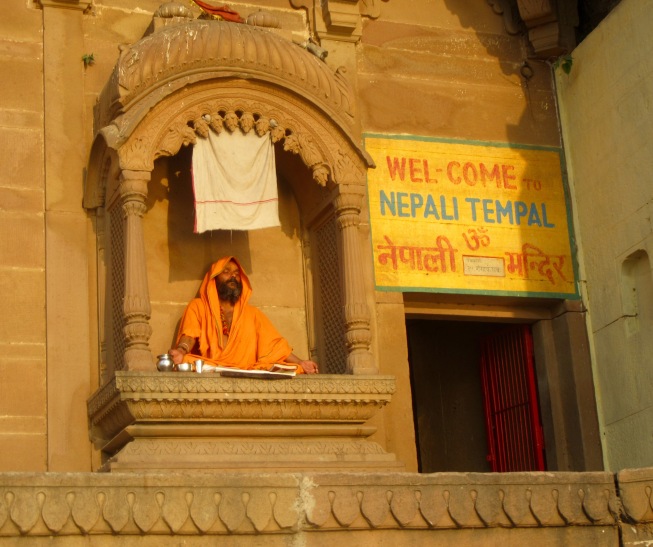
Bathing in the Ganges – it was so hot we were (almost) tempted to join them.
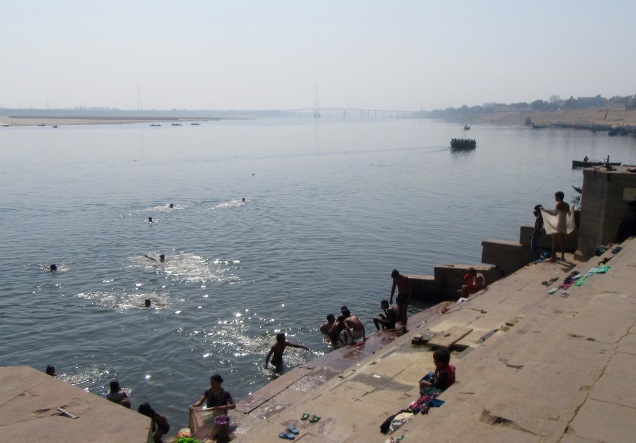
Typical alleyway.
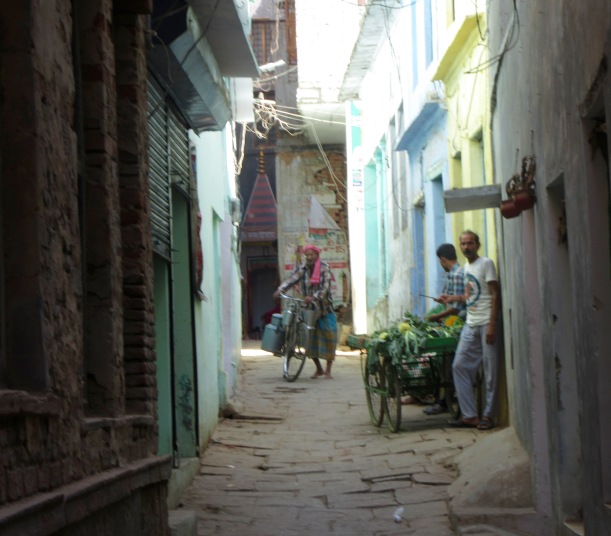
Cricket being played on many of the ghats.

The magnificence of some of the buildings.

Early morning clean-up.

Laundry hanging on a line – fresh from the Ganges.
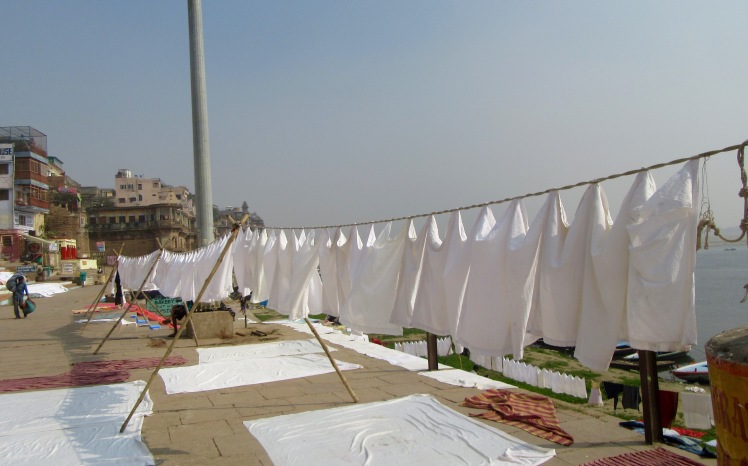
The animals of Varanasi have adapted to their surroundings. The cows climb up and down steps easily.
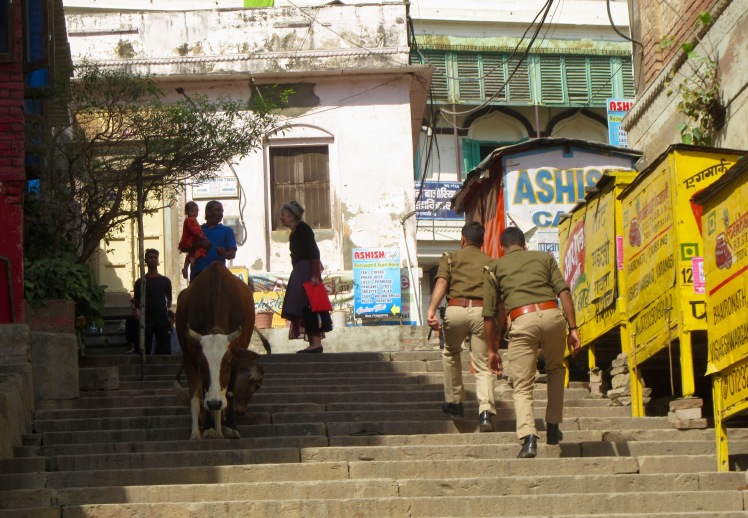
The goats are naturally built for heights.
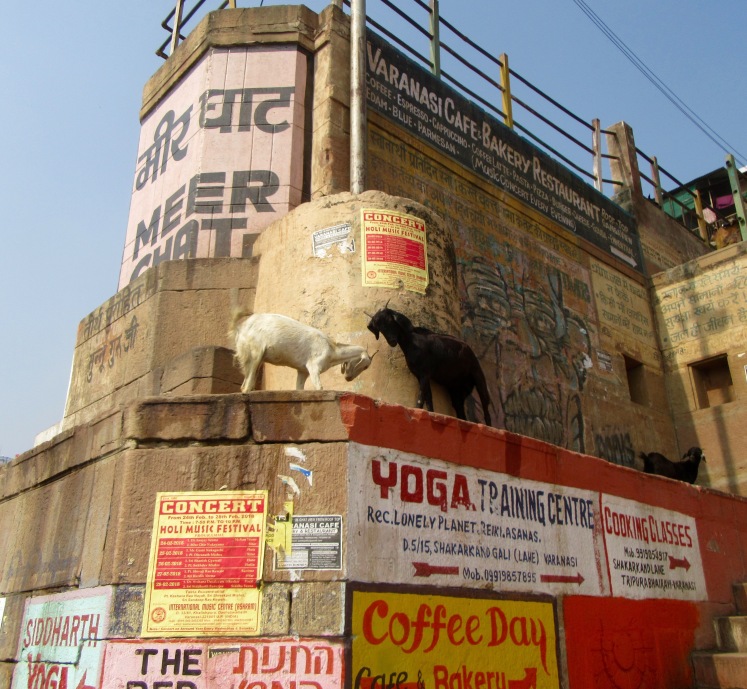
Varanasi in the early morning.
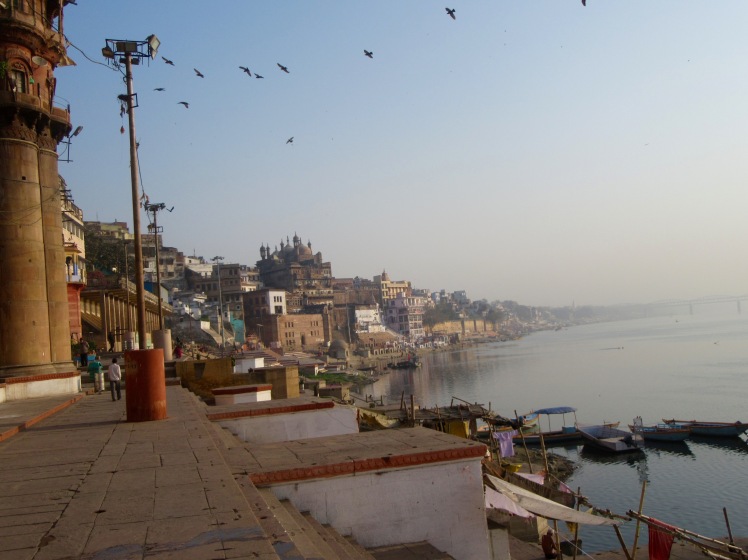
Flower seller
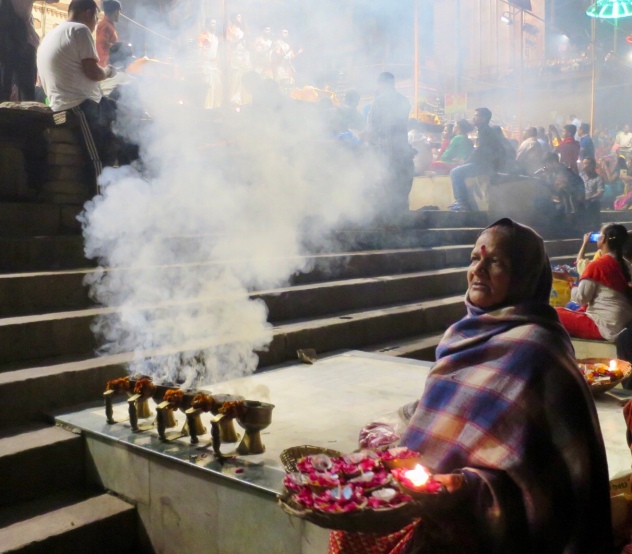
Whew! This was a tough one – to experience and to write about. We talked to people who love Varanasi, have come here many times and intend to return. We can’t get out of here fast enough. Maybe we’re missing something. But we are very happy we came here. This was an eye-opener and will stay with us for a long time.
On to Rajasthan – home of palaces, forts, deserts, camels and snake charmers. We land in Jaipur tomorrow.
Love your honest opinions. We felt exactly the same. You now have beautiful Rajasthan to look forward to. Hugs Sheila and Jim
LikeLike
Driving into Jaipur today was wonderful. Cooler temps, big modern buildings, a minimum of garbage, very efficient. We are really looking forward to exploring.
LikeLike
I am impressed. I could not walk in your shoes. This was so hard to read and even harder to view the pictures. So much poverty and suffering and what can you do but walk on by. Their government certainly doesn’t feel any obligation to look after the population which is so frustrating.
Trump has the US heading down the same path.
You are both so brave. Did you feel safe? No mention of any aggression. Please take care.
Joan
LikeLike
We feel very safe in India. The vendors and beggars are persistent but I wouldn’t say aggressive. Indian people by and large are not rough; until it comes to them butting in line – that is a whole other story!
We are way safer here than we would be in many North American cities – we just take precautions with our stuff, but in no way fear for our physical safety.
LikeLike
You’re a brave couple! And you can have India! Unrelated – I sometimes wonder. What does Steve do while you’re writing these posts?
LikeLike
Honestly Peter we are not brave, although Varanasi was put-through, but every other place we’ve been has been easy.
As for Steve – my blog-writing time serves as a good break from one another. He is in charge of booking travel arrangements, and checking out hotels, so he’ll often use that time to plan. He’s also on Instagram,so he flips through that for an hour or so.
LikeLike
Wow, I don’t have a way to reconcile my feelings about the state of existence for these disadvantaged souls. I deeply appreciate what you have shared, how respectfully you have shared and this profound journey of travel; of seeing, and of learning that you are sharing. Thank you. Wishing you continued safety.
LikeLike
Thanks so much Bridget. We’re avoiding the big cities – Kolkata, Mumbai, Delhi (except for our flight home) for those reasons – it is too difficult to witness. I you can believe it, those cities offer “slum tours” which I find distasteful.
We’ve talked to a number of young women who have spent time working in India – with children, or improving safety for women in villages, or installing toilets in villages,etc. I admire their attitudes – they are able to separate the misery and concentrate on solutions.
LikeLike
Sadly, very descriptive. I could picture the ‘horks’, thanks for sharing, amazing journey and photos.
LikeLike
Yeah, sorry about the horks – I know that brings up disgusting images. We wonder why horking and spitting is so common in India, but it could be the air – so dirty and smoky and thick.
LikeLike
Hi Ginny: A difficult post to read, especially as I was eating my breakfast. My take away is gratitude – for the lives we live in Canada. My prayers go out to these people, especially the children. My heart is broken. Stay safe. xo
LikeLike
Oh we feel so lucky every day here – why did we have the good fortune to be born in Canada, to caring families, and have so many opportunities? Just an accident of birth makes all the difference to how our lives will unfold.
LikeLike
To steal your words … “whew”, to read your blog “was a tough one.” How overwhelmingly devastating. It’s very near impossible to wrap your head around. Trust you to look for the good in all of this by including the photos at the end. Thank you for that.
LikeLike
Oh Heather, we knew before we came to India that we would see anything and everything, but boy, we were not really prepared for what that meant. It is impossible to wrap our heads around – nothing to do but accept that is the reality here and try and focus on the many small and delightful moments.
LikeLike
Such mixed emotions as I read this. Your writing, as always, made the experiences you had in Varanasi come alive . I could ‘smell ‘ the smells , panic at the chaos , cry for children and feel my heart rate go up watching each of your movie clips. Thank you for ending with the beautiful photos for us all to finish reading this blog on a peaceful note.
LikeLike
Pippa it is the only way to travel here – absorb the intolerable and look for the good moments. I was just sick for two days – don’t think I wasn’t lying in bed plotting my escape! Feeling better now and the journey continues.
LikeLike
Oh my Ginny, I’m feeling quite a lot of sadness, and gratitude after reading this and seeing your pictures. I’m reminded of travelling in Indonesia a number of years ago, seeing so many people living and begging on the streets of Jakarta, living in abject poverty and despair. We are so fortunate to be living in our little corner of Canada, and yet we have so many issues here too, perhaps not so profound and widespread as you’re experiencing there, but some difficult issues of homelessness and poverty that continue to confound us. Thanks again for sharing, take good care! Namaste.
LikeLike
I tell you – after travelling here for several weeks, the word “gratitude” is by no means a throw-away word anymore. We know to our bones how lucky we are now. I feel ashamed of myself when I remember how I was wanting to replace our old white appliances with something “better.” How do we bring these lessons home and learn how to be happy with less – because less is all we need.
LikeLike
This is yet the way of much of the world. I like the kid at the “toll booth”- and probably would have stepped over his stick, then given him a bill, with a wink. I would then have moved along with a purpose, to avoid the witnesses and their outstretched hands.
LikeLike